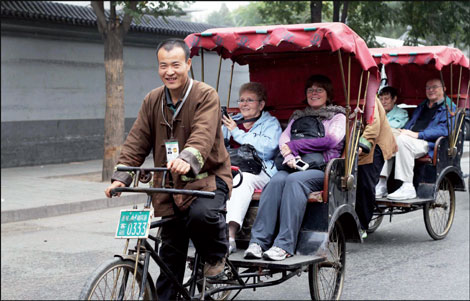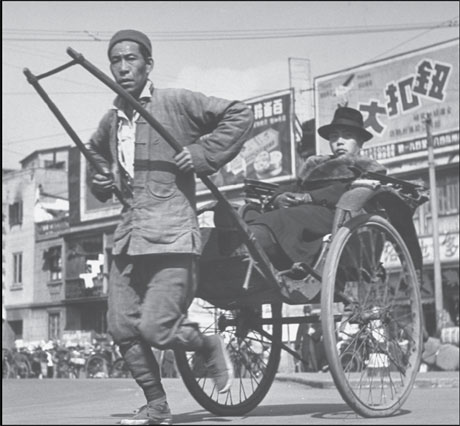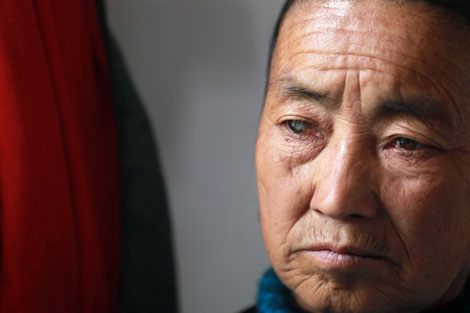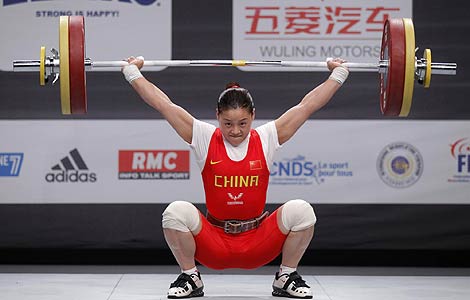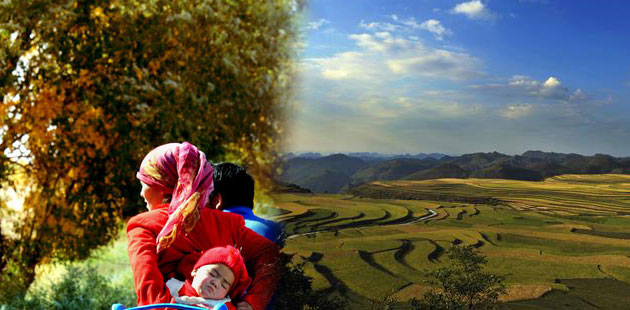Pushing ahead
Updated: 2011-11-13 12:06
By Sun Yuanqiang (China Daily)
|
|||||||||
|
Zhao Xiaoqiang has been a rickshaw rider in Beijing for more than two years and 80 percent of his customers are foreign tourists. Wang Jing / China Daily |
|
Hand-pulled rickshaws were a popular mode of transport in Shanghai in 1948. By the 1950s, they were replaced by cycle-powered rickshaws. Provided to China Daily |
The humble rickshaw still offers opportunities for Chinese migrant workers, Sun Yuanqiang reports in Beijing.
'Rickshaw' is one of the few English words Zhao Xiaoqiang can say but despite his limited vocabulary his sales pitch of "two people, one rickshaw" to foreign tourist earns him a relative decent salary. Like tens of millions or his countrymen, the 32-year-old former Shanxi farmer is a migrant worker who tried his luck in the big city.
"The competition among riders can be pretty tough. So the better you communicate with the passengers, the more you can earn," says Zhao, who has managed to save 30,000 yuan ($4,371, 3,420 euros) in two years, much more than he could have earned in his hometown.
Zhao's prosperity is the result of more tourists flocking to Beijing. First-time visitors to the city often head straight to the Great Wall or the Summer Palace in their efforts to truly appreciate the rich history and grandeur of the capital. But to enjoy a more relaxed and intimate experience of the old city, a winding pedicab ride through the hutong is hard to beat.
These cycle-driven rickshaws are making a comeback as the nation's tourism boom continues to gather pace.
Pedicabs in Beijing are mostly confined to the capital's downtown area, where a lot of famous alleys are located, and provide both pleasure for tourists and employment for migrant workers.
Traveling at a leisurely pace and at a cost of 30 yuan an hour, the pedicab has become increasingly popular with tourists, not just in Beijing but also in other Chinese tourist cities, such as Hangzhou and Shenzhen. The old-fashion nature of the device has special appeal to newcomers from all walks of life.
Hilary Clinton, Bill Gates and International Olympic Committee president Jacques Rogge have all used this classic means of transportation as well as regular folks.
"It's just different," says English tourist John Michael. "We took the rickshaw instead of the cab so that we could see the place better. It's also easier to maneuver a rickshaw than a cab in the narrow space of hutong."
Foreign tourists represent about 80 percent of the fares for pedicab riders, but the number of Chinese tourists using the old transport has been rising in recent years as domestic spending power grows, according to Zhang Yuerong, manager of the Beijing Hutong Tourist Agency.
Tian Jun, a 25-year-old white-collar worker from Shenzhen in South China, is a good example.
"This is the first time I've been to Beijing and the first time I've been on a pedicab. It's very relaxing sitting in the back booth and seeing what the local life is like," he says.
During a pedicab ride tourists can visit local courtyards, also known as siheyuan, and join residents as they chat, make and eat dumplings.
"Beijing has so much more to offer besides grand towers and roast duck," says Zhang. "The real Beijing lies in these small hutong, where local people live. And that's exactly what rickshaws bring to you."
Zhang, who started as a rider himself 17 years ago and has since built up his own agency, says pedicabs continue to charm tourists because they reflect old China and a time when rickshaws were everywhere.
Introduced from Japan in the late 1890s, traditional man-pulled rickshaws emerged as the most popular mode of transportation, replacing sedan chairs, which needed two, four or even eight people to carry passengers. Rickshaws remained popular in the 1930s, despite the rise of tramcars and buses, and customers included politicians, businessmen, journalists, students and tourists, according to David Strand, author of Rickshaw Beijing: City People and Politics in the 1920s.
Unlike Shanghai and Hangzhou in East China, the majority of Beijing's rickshaw operators were local people.
"This was because Beijing was relatively slow in modernization and industrialization in the first half of the 20th century compared with coastal cities," according to Qiu Guosheng, associate professor of history at Sichuan University.
The rickshaw men came from all walks of life, and included some very colorful characters: unemployed craftsmen, bankrupt peddlers, as well as dismissed public servants.
Descendents of royal "blue bloods", who had once lived in the Forbidden City, also became rickshaw operators after the fall of Qing dynasty.
"It was tough work. Pullers had to endure extreme weather, and often suffered frequent beatings from the police, just to earn a meager income only enough for a two-child family," says Qiu. "But the pulled rickshaws were largely replaced by cycle rickshaws after 1949, when the People's Republic of China was founded. The old rickshaw pullers were seen as a symbol of human inequality."
Qiu says that from the 1950s to the 1980s the cycle-powered rickshaw was used as a complementary means of transportation to tramcars.
By the early 1990s there was a surge of pedicab operators with more than 1,000 men plying their trade around the inner city area.
Their increased presence caused traffic congestion and authorities received complaints about over-charging non-Beijingers and foreign tourists.
Measures were taken and by 2007 in the leadup to the Olympics the number of rickshaws was restricted to 300.
Now legal rickshaw riders can be easily identified through their uniforms and vehicles. Most are former farm workers from Gansu, Shanxi and Henan provinces in northern China and normally receive one-month training in language, manners and routes before they steer a pedicab.
Zhao's company pays him 500 yuan per month as the basic salary, which covers the rent of his five-square-meter room without heating system. The rest he earns from tips, which can be relatively substantial if he is busy.
"Autumn is a good time for business as the weather is fine. We get about 30 tourists a day in peak times," Zhao says. Tips range from 1,000 yuan to 5,000 yuan a month depending on passing trade.
Most of Beijing's rickshaw drivers are introduced to the job by friends and some have been doing the job for more than 10 years.
